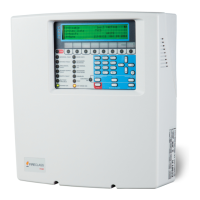
Do you have a question about the FireClass FC500 and is the answer not in the manual?
| Brand | FireClass |
|---|---|
| Model | FC500 |
| Category | Control Panel |
| Language | English |
Steps to install the FireClass FC500 Console application on a computer.
How to choose the application language from the provided list.
Connecting the control panel to the computer via RS232/USB or LAN.
Managing customer installation files, including new, open, save, and close operations.
Creating a new installation and setting default programming parameters.
Retrieving previously saved customer installation files.
Selecting the console's display language.
Changing the console's visual appearance or theme.
Configuring tooltips, USB drivers, and file associations.
Accessing technical support files and learning how to use the console.
Viewing and managing information about the control panel's hardware and software.
Accessing specific panel information like firmware and serial ID.
Configuring the IP address for the FC500IP module.
Using a dynamic DNS service for remote panel monitoring.
Changing the language displayed on the panel's user interface or repeater.
Updating the firmware of the control panel's components.
Configuring text displayed on the panel's LCD during standby.
Entering and managing account data for identification and monitoring.
Adding, removing, and configuring devices on the panel's loops.
Calculating the maximum permitted loop resistance based on cable length.
Configuring individual parameters for fire detectors.
Configuring detector-specific settings like enabled status and assigned zones.
Selecting and configuring detector bases, including sounder base options.
Activating and programming the remote LED function for detectors.
Understanding detector classification based on temperature response.
Defining panel actions for Warning and Delay to Alarm events.
Configuring heat detector behavior in Day/Night modes.
Configuring smoke detector behavior with drift compensation and sensitivity.
Configuring CO detector behavior with sensitivity and immunity settings.
Programming parameters for input modules.
Selecting and configuring sounder bases for output modules.
Selecting conditions that activate output modules (zones, points, etc.).
Programming parameters for MI/O modules like FC410MIO/FC410QIO.
Configuring parameters for manual callpoints.
General settings for zones, including enabled status and label.
Zone-specific options like walk test and delay to alarm settings.
Configuring delay to alarm and double knock for zones.
Configuring PSTN and IP communication modules.
Configuring PSTN communication settings.
Configuring IP communication settings.
Configuring supervised, silenceable alarm outputs.
General settings for SC outputs, including enabled status and label.
Associating zones with SC outputs for triggering.
Defining input points that trigger outputs.
Setting up loop wiring, power supply, and disabling options.
Selecting 2-wire or 4-wire connection for panel loops.
Managing user access levels and codes for the control panel.
Enabling and configuring PSTN and FC500IP modules.
Enabling PSTN functionality and selecting call types.
Configuring network settings, repeaters, and client panels.
Programming various delay timers and thresholds.
Setting the delay for signaling a mains failure.
Configuring the maximum silence time for outputs.
Configures Pulse on, Detector alarm, Delay to alarm, and Warning events for sounders.
Configuring tone, volume, and beacon for different sounder types.
Activating and configuring the PSTN interface.
Setting call attempts, iterations, and tone check for PSTN.
Setting conditions for voice message playback.
Configuring parameters for periodic system tests.
Configuring the FC500IP module for network communication.
Setting DHCP, static IP, and Ethernet speed for the IP module.
Setting general options for the IP module, including encryption and board settings.
Configuring IP address and ports for central station and backup receivers.
Advanced IP module settings like trouble masks and output polarity.
Setting the operating mode for OC outputs on the IP module.
Programming event details, including phone numbers and voice messages.
Setting the control panel's date and time, including daylight saving.
Displaying and managing the log of stored events.
Accessing utility functions like battery calculations and firmware loading.
Setting standby hours and alarm minutes for battery calculation.
Specifying the battery type (Ah) for calculations.
Locking standby hours or battery type during calculation.
Locking the standby hours value in battery calculation.
Enabling or disabling devices and zones in real-time graphic maps.